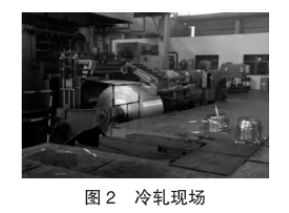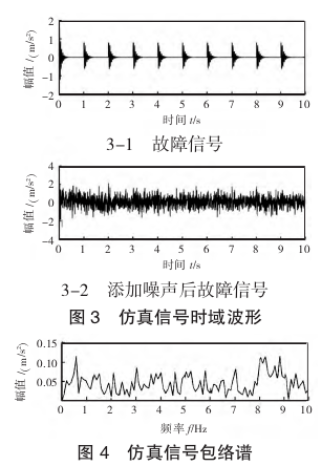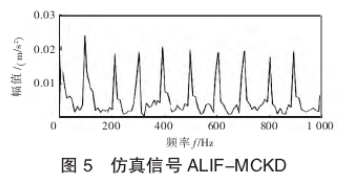
Abstract: Cold rolling mill is prone to bearing failure damage under high load operation. In order to improve the anti-interference ability of bearing vibration signal in complex environment, a bearing vibration signal processing and fault diagnosis method based on ALIF and MCKD methods is designed. The simulation signal and bearing signal are tested, and the method meets the reliability requirements. The research results show that the envelope spectrum can analyze the 100Hz fault characteristics and the corresponding frequency doubling components, and has an obvious suppression effect on the noise signal, and can accurately extract the fault signal. This research is helpful to improve the fault diagnosis ability of traditional mechanical systems, and has high market promotion value.
Key words: bearing; Fault diagnosis; Adaptive local iterative filtering; Correlation kurtosis deconvolution
0 Introduction
When cold rolling mill equipment is running, it will produce weak characteristic signal in the initial fault stage, but it is easy to be covered by background noise and can not be accurately diagnosed. As the degree of failure continues to increase, it will eventually cause irreversible damage. Therefore, it is necessary to develop appropriate fault detection technology to achieve accurate capture of equipment fault signals [1-3]. The EMD method does not establish a strict mathematical derivation formula, and when singular points are generated in the signal, the result of mode aliasing will be caused. When cubic spline interpolation is used for processing, the problem of underfitting or overfitting will also occur, and unstable changing characteristics will easily appear in the noisy environment [4]. Huang Siqi et al. [5] developed an iterative filtering algorithm (IF), which adopts the architecture consistent with EMD, establishes the upper and lower envelope function through the low-pass filtering method, and then calculates the mean data for fault diagnosis. Deng Minqiang et al. [6] constructed the FP differential expression, set up the basic solution system on this basis to realize the extended application of the IF algorithm, and designed an iterative filtering method (ALIF) that can perform adaptive processing on local functions. ALIF can efficiently process the wave signal of the nonlinear change process, and iteratively filter the processed data to obtain the IMF component [7]. Compared with EMD method, ALIF has stronger decomposition efficiency and mode aliasing suppression effect, and the algorithm has better comprehensive performance. At present, ALIF algorithm has been widely used in mechanical fault diagnosis. By combining ALIF with energy operator demodulation, the frequency characteristic value of bearing fault is extracted, which greatly improves the fault diagnosis accuracy.
In this paper, the bearing running state of cold rolling mill is studied, and the bearing fault diagnosis is realized by using ALIF and MCKD methods. Simulation signal test shows that the method meets the reliability requirement.
1 Introduction to basic theories
1.1 Adaptive Local Iterative Filtering (ALIF)
ALIF algorithm is an adaptive decomposition algorithm by improving the iterative filtering algorithm (IF). ALIF is often used to construct FP differential equations and to build adaptive filter functions. Therefore, before analyzing the principle of ALIF algorithm, we should first understand the operation mechanism of IF algorithm.
IF and EMD are two similar algorithms. After iterative calculation, the corresponding intrinsic modal components (IMF) are filtered. The ALIF algorithm uses the filtering function and the convolution process of the data to be decomposed to determine the sliding operator, instead of the fitting process of the EMD algorithm to calculate the envelope value. The IF algorithm consists of two parts: inner loop and outer loop.
For the preprocessed signal X (t) and the filter function f (t), the sliding operator Γ (X (t)) can be obtained according to the convolution result of X (t) and f (t) :

Where: f (t) is a fixed low-pass filter function; h (z) is the corresponding filtering interval.
According to the difference between the preprocessed signal X (t) and the sliding operator Γ (X (t)), the wave operator K (X (t)) is obtained:

Analyze whether the wave operator K (X (t)) can meet the IMF component standard, and take the wave operator meeting the standard requirements as the IMF component. On the contrary, the wave operator is filtered. The specific processing process is as follows:
1) The pretreatment signal filtering interval h (z) is determined by processing.
2) Calculate the sliding operator Γ (X (t)).
3) Determine the wave operator K (X (t)).
The wave operator function in filtering processing:

If IMF (t) meets the IMF weight criteria, the primary IMF weight is extracted. Otherwise, go to Step 1) continue processing until the set condition is met.
1.2 ALIF-MCKD bearing early fault diagnosis method
FIG. 1 shows the specific process of ALIF-MCKD bearing fault diagnosis.
1) The ALIF of vibration signal is decomposed to form IMF component and corresponding residual component.

2) The sensitive IMF component is selected by combining correlation coefficient and kurtosis, and then reconstructed to complete the noise reduction process.
3) MCKD algorithm is used to improve the fault impact part of the reconstructed noise reduction signal, and then the envelope spectrum is calculated.
4) Extract the fault characteristics and determine the bearing fault location.
2 Verify the effectiveness of ALIF-MCKD method
old rolling mill often appears different forms of vibration phenomenon, the main transmission system loading load, will aggravate the occurrence of vibration. In this paper, the vibration signal test and analysis were carried out on the MSK-5070 cold rolling mill. The field photos are shown in Figure 2.

In order to verify the effect of the combination of ALIF and MCKD, the bearing fault cycle impact characteristics of cold rolling mill were used to establish the simulation signal, and then the simulation signal expression was as follows:

Where: x1 (t) is the impact signal caused by the fault; n (t) is noise with amplitude 1; x (t) is the signal obtained from the simulation test of the bearing fault; The displacement constant is set as A1=2, the bearing natural frequency fn=2000Hz, and the corresponding damping coefficient is ζ=0.1.
The shock failure period is T=0.01s, which is equivalent to the characteristic frequency of f=100 Hz. Sampling is performed at the frequency of fs=20k Hz and the number of samples is N=2048. Figure 3 shows the time-domain waveform of the simulation test. FIG. 4 shows the envelope spectrum of the fault signal. When affected by environmental noise, no obvious fault characteristics are formed, and other multiple frequency interference is also encountered.

The correlation core-kurtosis method is used to determine IMF1 and IMF2, and the reconstruction noise reduction process is completed. The MCKD algorithm is used to achieve the noise reduction of the reconstructed signal, and the envelope spectrum is used to complete the demodulation analysis. The results are shown in Figure 5. The envelope spectrum obtained by ALIF and MCKD can analyze the 100Hz fault characteristics and the corresponding frequency doubling components, which shows that the above method has an obvious suppression effect on the noise signal and can accurately extract the fault signal.

3 Conclusion
In this paper, based on ALIF+MCKD method, bearing vibration fault signal processing analysis of cold rolling mill is carried out, and the following results are obtained:
1) MCKD algorithm is used to denoise the reconstructed signal, and then the envelope spectrum is used to complete the demodulation analysis.
2) The envelope spectrum can analyze the 100Hz fault characteristics and the corresponding frequency doubling components, which has a significant suppression effect on the noise signal and can accurately extract the fault signal.
【 Reference 】
[1] Liu Hongjun, Wei Xuyang. Research on Bearing Fault Diagnosis based on GADF and Convolutional Neural Network [J]. Mechanical and Electrical Engineering, 2021,38 (5) : 587-591.
[2] Yang Xu, Peng Kaixiang, Luo Hao, et al. Diagnosis of Vertical Vibration Related Faults of Cold rolling Mill based on EEMD and SVM [J]. Journal of Shanghai Jiaotong University, 2015,49 (6) : 751-756. (in Chinese)
[3] Yuan Linzhong, Chen Baowei, Li Yanhua. Research on Key Technologies of Hydraulic Fault Diagnosis Expert System for Cold Rolling Mill [J]. Machine Tool & Hydraulics, 2008,243 (9) : 160-162.
[4] Li Yi, Li Huanfeng, Liu Zansi. Research on Bearing Fault Diagnosis based on CEEMDAN multi-scale entropy and SSA-SVM [J]. Journal of Mechanical and Electrical Engineering, 2019, 38 (5) : 599-604.
[5] Huang Siqi, Zheng Jinde, Pan Haiyang, et al. Fault diagnosis of rolling bearings based on Maximum correlation Kurtosis deconvolution and Fourier decomposition [J]. Mechanical Science and Technology, 2019, 39 (8) : 1 163-1 170.
[6] Deng Minqiang, Deng Aidong, Zhu Jing, et al. Intelligent Fault diagnosis of wind power Rolling Bearing based on BFD and MSCNN [J]. Journal of Southeast University (Natural Science Edition), 2019, 51 (3) : 521-528. (in Chinese)
[7] Chen Baojia, Wang Xinbo, Zhao Chunhua, et al. Bearing fault feature Extraction based on adaptive local iterative filtering and energy operator demodulation [J]. Journal of Nanjing University of Technology, 2018,42 (4) : 445-452.